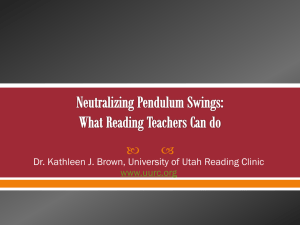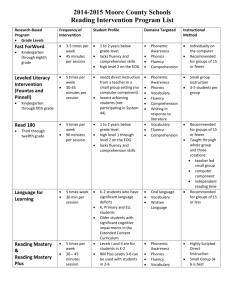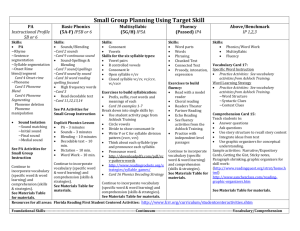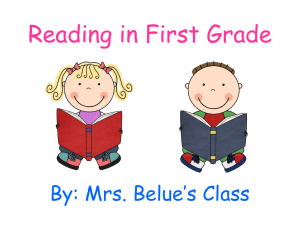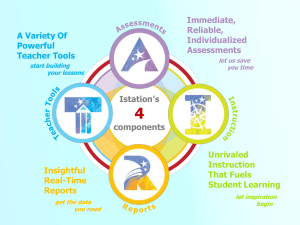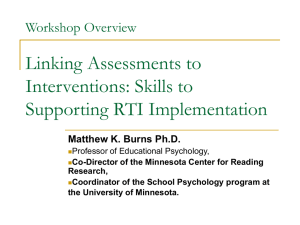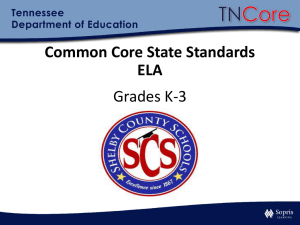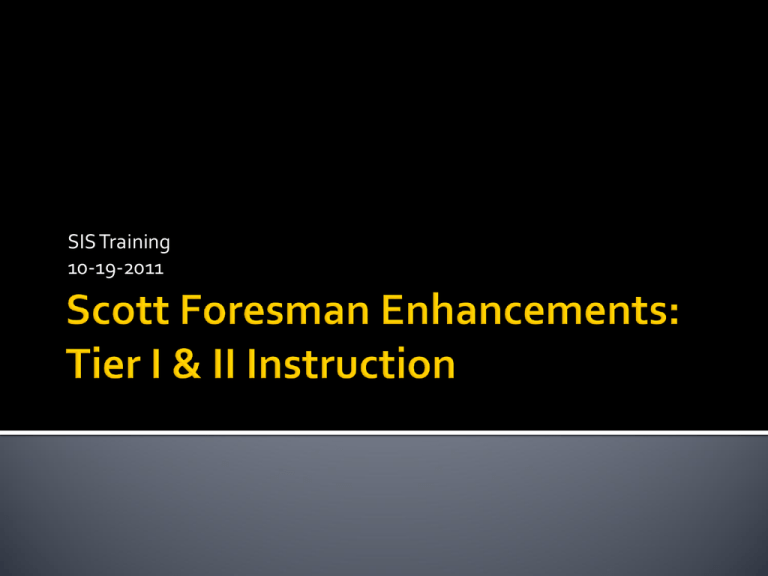
SIS Training
10-19-2011
Build sufficient background knowledge in phonemic
awareness and phonics to support the coaching of K-2
teachers in the effective use of Scott Foresman by:
Tracing instruction in the 5 Big Ideas using Unit & Weekly
Planner and Daily Lessons
Examining effective instructional techniques
Learning Enhancement ( Tier II) instructional routines and
procedures
Read article
Choose quote that resonates with you.
Whole group sharing
“Students who are not reading at grade level by the
end of first grade have a 1 in 8 chance of ever
catching up to grade level without extraordinary
and costly intervention.” Juel, 1988, 1994
Phonemic Awareness
Phonics
Fluency
Vocabulary
Text Comprehension
Matthew Effect
+ Wide reading
+ Comprehension
+ Vocabulary
+ Reading
+ Phonics
+ PA
- PA
- Phonics
- Reading
- Vocabulary
- Comprehension
- Little reading
Stages of Reading Development
PRE-ALPHABETIC or
PRE-LITERATE
Pre-k
PARTIAL or EARLY
ALPHABETIC
cat fog
pet rim
Late k to
early grade 1
FULL or LATE
ALPHABETIC
street rake
sing turn
Late grade 1 to early
grade 2
CONSOLIDATED
ALPHABETIC or
ORTHOGRAPHIC
un-re-li-a-ble
Late grade 2
un-reli-able
Grade 3+
Ehri 1995, Moats 2000
Copyright © 2006 Ashlock Consulting Inc.
All rights reserved.
Module 1 (K-3)
7
Organization of Teacher Manual
Activity
• What is located on pp. 4-5(K) or pp. 10d-10e (1st)?
• What is located on pp. 6-9 (K) or pp. 10f-10i (1st)
• What is located behind the Differentiated Instruction Tab at the
back of the TE?
• What does the red “T” signify? ( Use Weekly Planner)
• Looking at each day of instruction, are the 5 big ideas included?
(Use Weekly Planner)
Copyright © 2006 Ashlock Consulting Inc.
All rights reserved.
Module 1 (K-3)
8
Text Types
Text
Types
Descriptions
Primary
Purposes
Other Purposes
Decodable
80% of words have previously
taught sound spellings
Apply phonics skills on
connected texts
High frequency words,
Fluency
Leveled
Leveled by readability
Comprehension,
Vocabulary, connect to
theme
High frequency words,
phonics skills, Fluency
Authentic
Literature, trade books,
anthology
Comprehension,
Vocabulary, connect to
theme
High frequency words,
Fluency
Copyright © 2006 Ashlock Consulting Inc.
All rights reserved.
Module 1 (K-3)
9
Why Scott Foresman Enhancements?
1. Provide instructional guidance that is more
explicit.
2. Provide multiple exposures and more
opportunities for practice.
3. Prioritize teaching the Big 5 Ideas in Scott
Foresman
Copyright © 2006 Ashlock Consulting Inc.
All rights reserved.
Module 1 (K-3)
10
Five Big Ideas in Reading Instruction
• Phonemic Awareness
• Phonics
• Fluency
• Vocabulary
• Text Comprehension
Concept of word-comparison and segmentation
Rhyme-recognition and production
Syllable-blending, segmentation, deletion
Onset-Rime-blending, segmentation
Phoneme-matching/isolation, blending
segmentation, deletion, manipulation
©Ashlock Consulting, 2006
Significance of Phonemic Awareness
The best predictor of reading difficulty in kindergarten or first
grade is the inability to segment words and syllables into
constituent sound units (phonemic awareness).
Lyon 1995
Poor phonemic awareness at four to six years of age is
predictive of reading difficulties throughout the elementary
years.
Torgesen and Burgess 1998
More advanced forms of phonemic awareness (such as the
ability to segment words into component sounds) are more
predictive of reading ability than simpler forms (such as being
able to detect rhymes).
Nation and Hulme 1997
Copyright © 2006 Ashlock Consulting Inc.
All rights reserved.
Module 3 (K-1)
13
Clear and Explicit
Phonological Awareness Instruction
•
Recognize and state the purpose of the
activity.
•
Scaffold instruction using hand signals and/or
manipulatives.
•
Do not write the words on the board.
•
Elicit whole-group responses.
•
Provide sufficient repetition.
Copyright © 2006 Ashlock Consulting Inc.
All rights reserved.
Module 3 (K-1)
14
Activity:
Work with a partner.
Find a phonemic awareness lesson in Scott
Foresman.
Evaluate it using the criteria on the previous slide
as a checklist.
Template Introduction
Cards # 6 – Phoneme Segmentation
Model
Practice
Phonemic Awareness
Phonics
Fluency
Vocabulary
Text Comprehension
Explicitly teaching students to convert
spellings into sounds and then to blend the
sounds to form recognizable words.
Converging research has found that effective
readers use their phonics knowledge to
decode through the entire word.
Unison Oral Responding
Signaling
Pacing
Monitoring
Correcting Errors and Teaching to Mastery
Carnine, Silbert, Kame’enui, Tarver, 2004
Practice with a partner the introduction of a
sound spelling incorporating effective
instructional techniques ( Examples 2)
Model - Card #7 Sound Spelling Review
Practice - Work in groups of 2
Alternate role of student and teacher
Build sufficient background knowledge in phonemic
awareness and phonics to support the coaching of K-2
teachers in the effective use of Scott Foresman by:
Tracing instruction in the 5 Big Ideas using Unit & Weekly
Planner and Daily Lessons
Examining effective instructional techniques
Learning Enhancement ( Tier II) instructional routines and
procedures
Talk at your table. How will the information shared today
support you in your coaching?


